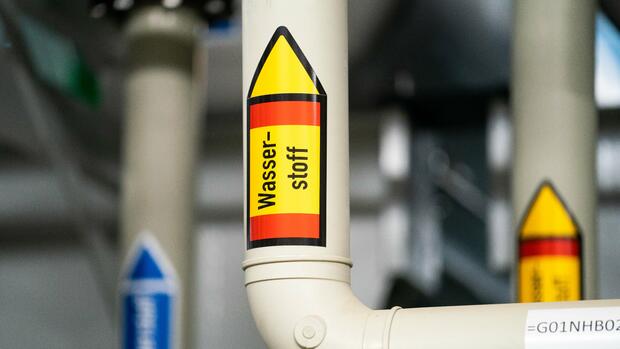The federal government wants to advance the development of a hydrogen economy.
(Photo: dpa)
Berlin The federal cabinet is to decide on the update of the national hydrogen strategy in July. The Handelsblatt learned this from negotiating circles. With the decision, the federal government wants to promote the ramp-up of a hydrogen economy in the coming years.
The updated version, which the ministries involved have now agreed on, was forwarded to the National Hydrogen Council for comment. The joint version of the ministries is dated 10 July. It is available to the Handelsblatt.
This ends a months-long dispute, because the new version of the strategy should actually have been decided long ago. But for a long time there were different opinions, especially between the departments of economy and transport.
The Green Ministry of Economics originally wanted to limit the use of climate-neutral hydrogen essentially to use in industry, in air, heavy-duty and shipping traffic and for the operation of back-up power plants, which should always be used when there is wind and sun not supply enough power.
The FDP-led Ministry of Transport, on the other hand, had demanded that hydrogen also be widely used in the transport sector and also used to generate heat.
More important role for e-fuels
The update of the strategy now states that in the transport sector, “electrification with batteries and fuel cells and the use of electricity-based renewable fuels, in addition to traffic reduction and shifting, are the key levers for achieving climate protection goals”. Electricity-based renewable fuels, the so-called e-fuels, are produced on the basis of hydrogen produced in a climate-neutral manner.
The update also states that hydrogen and its derivatives are “an important building block for sustainable, climate-friendly mobility and complement other alternative forms of propulsion”. In this way, the transport sector can also contribute as a driver to the scaling of a hydrogen economy.
With regard to heating buildings, it is said that the framework conditions are currently being further developed in the Building Energy Act (GEG), in heat planning and in the European gas market package for the perspective use of hydrogen in heat supply.
>> Read also: Winners of the boom: Hydrogen could come from these regions
The National Hydrogen Strategy was presented in June 2020 by the previous government. The background is the goal of making Germany a climate-neutral economy by 2045. Climate-neutral hydrogen plays a key role in this. It can pave the way to climate neutrality wherever electricity from renewable sources is not a solution. This is the case, for example, in the steel, chemical and cement industries. Companies have to convert processes that are currently still operated with gas, oil or coal to hydrogen-based processes. From today’s perspective, there is no alternative to hydrogen in heavy-duty, air and shipping traffic on the way to climate neutrality.
In many industrial sectors, climate-neutral production will initially only be possible with hydrogen.
(Photo: imago images/Frank Ossenbrink)
According to various forecasts, the demand for climate-neutral hydrogen will increase rapidly in the coming years. The update to the hydrogen strategy therefore states that the federal government wants to significantly accelerate the market ramp-up of hydrogen technologies “and massively increase the level of ambition along the entire value chain”.
The hydrogen starter network should be ready by 2028 at the latest
To ensure that there is enough hydrogen, the target for domestic electrolysis capacity in 2030 is to be increased from five gigawatts (GW) to “at least ten GW”. The update of the strategy thus picks up on a passage from the coalition agreement.
The ministries involved are paying particular attention to the development of an efficient hydrogen infrastructure. The strategy states that by 2027/2028 a “hydrogen start-up network with more than 1,800 kilometers of converted and newly built hydrogen lines will be set up in Germany”. Across Europe, 4500 kilometers would be added. By 2030, “all major generation, import and storage centers will be connected to the relevant customers”.
The update no longer mentions state participation in a hydrogen network. Economics Minister Robert Habeck (Greens) had triggered heated discussions with a corresponding request, but had recently moved away from it. The operators of the long-distance natural gas pipelines are currently developing plans for the hydrogen network. They even go well beyond the 1800 kilometers of the start network.
In addition, uniform legal provisions, especially in planning and approval, are intended to promote market growth. This also includes an “adequately equipped and coordinated administration at all levels,” the paper says.
Federal government announces import strategy for hydrogen
A separate import strategy for hydrogen is intended to ensure availability, and a separate strategy is planned for this. In the past few months, the federal government has already sealed various hydrogen partnerships with other countries. The aim is to establish supply relationships with potential suppliers of green hydrogen.
The decisive vehicle for this is the “H2 Global” foundation, which the federal government has endowed with 4.4 billion euros. On the one hand, this concludes long-term purchase agreements abroad in order to give hydrogen producers planning and investment security. On the other hand, it agrees sales contracts to meet the need for green hydrogen. This is bought at the lowest possible price and then sold to the buyer who pays the highest price. If there is a loss in the first few years, as is currently expected, the foundation should compensate for it from the funds of the Ministry of Economics.
More: Who is behind Deutsche Regas?
